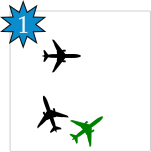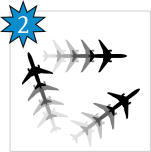Do you have what it takes to be an air-traffic controller? Test your skills by trying to track highlighted planes! How many can you track at once?

Once you press Start, planes you need to track will blink green for a short time.

Keep tracking target planes, while they fly around.

Was the yellow plane one of the planes you were tracking? Targets planes will blink green if you were correct and red, if you made a mistake.

How many planes can an average person track?
A typical person can reliably track four or five planes in the conditions like that. This is because there is a “bottleneck” within your cognitive system that limits the number of objects you can simultaneously attend to. This limit is also known as Miller’s Magical Number Seven, Plus or Minus Two (however, if you read the original paper, you will find that it is number Four that is the critical threshold).
Why is our cognitive capacity limited?
In short, because we do not have infinite computational resources in our brain. Our brain is very complex, stunningly powerful, and is capable of processing massive amounts of information in parallel. However, it is still limited in how many items it can examine in detail. To solve this problem, it is equipped with attentional control. Using your attention, you determine which objects in your visual field get priority and are passed on for detailed processing.
Can training increase my cognitive capacity and help me track more planes?
Yes, training will increase the number planes you can track. Unfortunately, training does not seem to increase you cognitive capacity. Instead, you learn to better control your attention and optimize the use of the computational resources of your brain. And the best part? Video games can help you in this!
References
-
Miller, G. A. (1956). The magical number seven, plus or minus two: Some limits on our capacity for processing information. Psychological Review, 63(2), 81–97 doi: 10.1037/h0043158
-
Green, C., Bavelier, D. (2003) Action video game modifies visual selective attention. Nature 423, 534–537. doi: 10.1038/nature01647